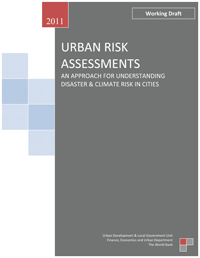
To date the predominant response to disasters, both within city governments and international agencies, has largely been reactive. Given the significant impact that natural hazards and climate change will have on urban investments, increasing priority is now placed on proactive, adaptive planning to reduce and manage the potential for disasters and climate change.
With this recognition, the value of identifying, diagnosing and mapping high risk areas is gaining visibility and importance. This has resulted in a proliferation of city risk and hazard assessments without a common approach.
In an effort to strengthen coherence on the issue and reduce duplication, the World Bank and key partners have combined related work undertaken across their organisations and produced a proposed framework for carrying out an urban risk assessment.
The report, Urban Risk Assessments: An Approach for Understanding Disaster & Climate Risk in Cities, was developed as part of a Memorandum of Understanding on a joint Cities and Climate Change work programme between UN-Habitat, UNEP, and the World Bank, supported by Cities Alliance.
Urban Risk Assessments presents a flexible approach that project and city managers can use to identify feasible measures to assess a city’s risk. The methodology focuses on three reinforcing pillars that collectively contribute to the understanding of urban risk: a hazard impact assessment, an institutional assessment, and a socioeconomic assessment.
An ancillary objective of the URA is to better position cities to absorb and allocate discrete adaptation funds (should they be available). There are no direct linkages between city level actions and National Adaptation Programs of Action (NAPA), and no funding schemes in place to finance their implementation. When compared to other sectors such as forestry or agriculture that have typically received sizeable allocations for climate adaptation funding, cities have lacked necessary mechanisms and tools to begin sustainably addressing climate change and disaster management.
About the Cities and Climate Change Joint Work Programme
UNEP, UN-HABITAT and the World Bank recognise the importance of climate change for cities and are working jointly to produce tools, programming and resources for cities as they respond to climate change. Within the framework of the Joint Work Programme, the Cities Alliance Secretariat is facilitating the partnership as well as providing technical, administrative, and financial support.




